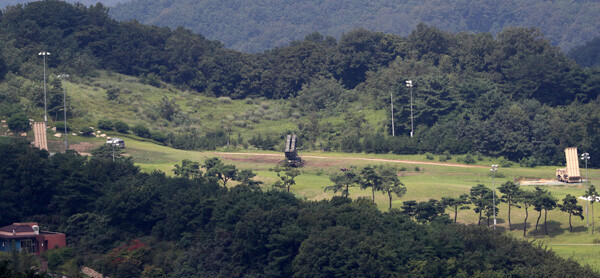hankyoreh
Links to other country sites 다른 나라 사이트 링크
South Korea’s “three no’s” announcement key to restoring relations with China

The recent agreement to restore relations between South Korea and China was achieved by having South Korea assuage China’s security concerns through public pronouncement of the “three no’s” – no additional THAAD deployment, no participation in the US’s missile defense network and no establishment of a trilateral military alliance with the US and Japan. But since the situation is liable to change with conditions on the Korean Peninsula and the interests of the countries concerned, it’s hard to say how the government’s promise of the “three no’s” will play out.
There’s not likely to be a push for additional THAAD deployments under the administration of South Korean President Moon Jae-in. For one, opposition to THAAD deployment is the prevailing view among the Moon administration’s base of supporters. Furthermore, since THAAD is designed to intercept enemy missiles at the high altitude of 40 to 150 km, it cannot defend the Seoul region, which is close to the armistice line, and can therefore only be deployed in the southern part of the country. Since one THAAD unit is already deployed in this southern area, there would seem to be little reason to deploy another. But if North Korea’s nuclear weapon and missile threat grows even more, South Korea could conceivably find itself under increasing pressure in a variety of ways to allow further deployment.
Seoul’s declaration that it will not participate in the US missile defense network has been the government’s basic stance going all the way back to the Kim Dae-jung administration. This is in consideration of China, which suspects that the US wants to build a missile defense network in northeast Asia to neutralize China’s military. In exchange, Seoul has announced that it will build what it calls “Korean Air and Missile Defense” through local development of M-SAM (medium-range surface-to-air missiles) and L-SAM (long-range surface-to-air missiles).
But South Korea and the US are also hurrying to set up a system that would enable detection and tracking information of missiles launched by North Korea to be shared in real time to facilitate the effective interception of those missiles. This would mean linking South Korea and American missile defense by means of sharing information. Such steps would naturally cause South Korea to move toward participating in US missile defense, some argue.
There’s virtually no possibility of a trilateral military alliance forming between South Korea, the US and Japan. Given popular sentiment in South Korea, it’s hard to imagine a military alliance being signed with Japan. Nevertheless, South Korea, the US and Japan have steadily expanded and strengthened their trilateral military cooperation. While the trend for strengthening trilateral military cooperation faltered for a while after former president Lee Myung-bak’s visit to Dokdo in Aug. 2012 and former president Park Geun-hye’s adoption of a hardline diplomatic stance on Japan in the spring of 2013, it has moved back into high gear amid the resumption of military diplomacy between South Korea and Japan following the comfort women agreement in Dec. 2015.
The navies of South Korea, Japan and the US have carried out joint missile warning exercises on five occasions since June 2016, and the three countries are also holding joint search and rescue exercise (called SAREX) every year. Meetings between the three countries’ joint chiefs of staff have also been held five times since July 2014. The pretext for all of these activities is North Korea’s provocations – but they are also motivated by the US and Japan’s shared interest in incorporating South Korea into a system of trilateral military cooperation to counter China’s military rise. If China grows even more powerful in the future, South Korea is expected to come under more pressure from the US and Japan to further strengthen trilateral military cooperation. This means that South Korea could once again find itself in the difficult predicament of being squeezed between pressure from the US and Japan to strengthen trilateral military cooperation and China’s backlash to these efforts.
By Park Byong-su, senior staff writer
Please direct questions or comments to [english@hani.co.kr]

Editorial・opinion
![[Column] Life on our Trisolaris [Column] Life on our Trisolaris](https://flexible.img.hani.co.kr/flexible/normal/500/300/imgdb/original/2024/0505/4817148682278544.jpg) [Column] Life on our Trisolaris
[Column] Life on our Trisolaris![[Editorial] Penalties for airing allegations against Korea’s first lady endanger free press [Editorial] Penalties for airing allegations against Korea’s first lady endanger free press](https://flexible.img.hani.co.kr/flexible/normal/500/300/imgdb/original/2024/0502/1817146398095106.jpg) [Editorial] Penalties for airing allegations against Korea’s first lady endanger free press
[Editorial] Penalties for airing allegations against Korea’s first lady endanger free press- [Editorial] Yoon must halt procurement of SM-3 interceptor missiles
- [Guest essay] Maybe Korea’s rapid population decline is an opportunity, not a crisis
- [Column] Can Yoon steer diplomacy with Russia, China back on track?
- [Column] Season 2 of special prosecutor probe may be coming to Korea soon
- [Column] Park Geun-hye déjà vu in Yoon Suk-yeol
- [Editorial] New weight of N. Korea’s nuclear threats makes dialogue all the more urgent
- [Guest essay] The real reason Korea’s new right wants to dub Rhee a founding father
- [Column] ‘Choson’: Is it time we start referring to N. Korea in its own terms?
Most viewed articles
- 1New sex-ed guidelines forbid teaching about homosexuality
- 260% of young Koreans see no need to have kids after marriage
- 3[Column] Life on our Trisolaris
- 4OECD upgrades Korea’s growth forecast from 2.2% to 2.6%
- 5Presidential office warns of veto in response to opposition passing special counsel probe act
- 6Months and months of overdue wages are pushing migrant workers in Korea into debt
- 7[Guest essay] Maybe Korea’s rapid population decline is an opportunity, not a crisis
- 8Trump asks why US would defend Korea, hints at hiking Seoul’s defense cost burden
- 9[Editorial] Penalties for airing allegations against Korea’s first lady endanger free press
- 10Japan says it’s not pressuring Naver to sell Line, but Korean insiders say otherwise